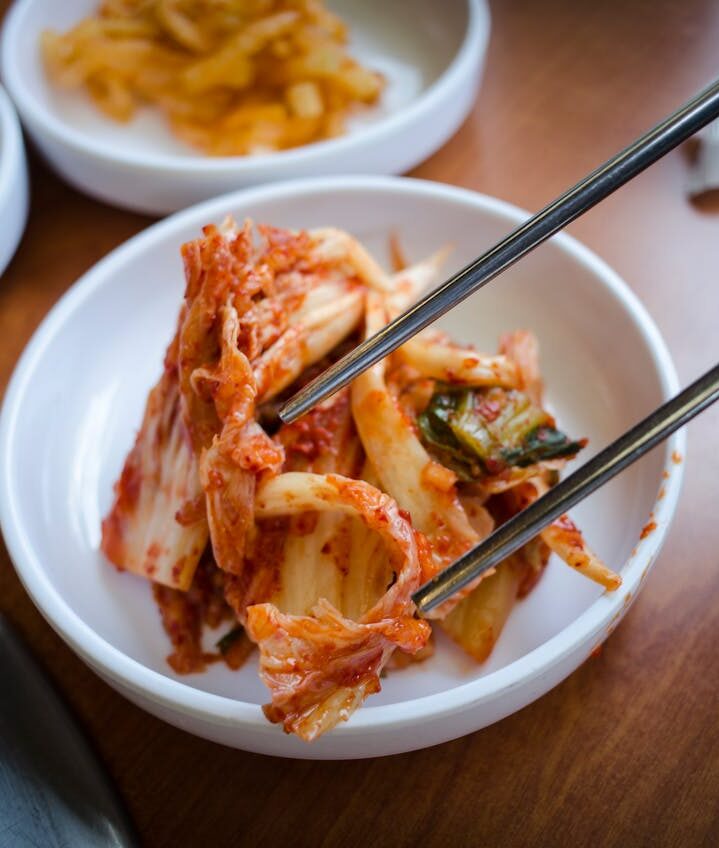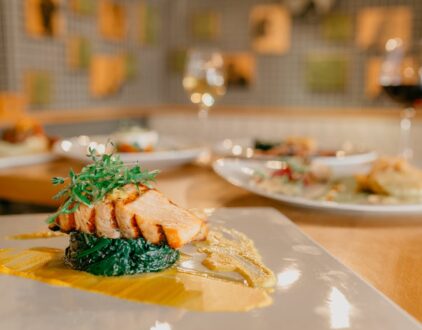Exploring international cuisine is so rewarding, as it allows you to expand your palate and explore food you may love and would have never known you would otherwise, including kimchi.
Kimchi is a traditional Korean dish made by fermenting vegetables, primarily napa cabbage and Korean radishes, along with various seasonings such as chili powder, garlic, ginger, scallions and salt. It is a staple in Korean cuisine and is enjoyed as a side dish or incorporated into various dishes. If you are wondering “what does kimchi taste like,” know that in short, it has a tangy, spicy and slightly sour flavor and is rich in probiotics, vitamins and minerals due to the fermentation process. It is often served alongside rice, soup or used as an ingredient in dishes like kimchi fried rice, kimchi stew (kimchi jjigae) and kimchi pancakes (kimchijeon).
Where Does Kimchi Come From?
The history of kimchi dates back thousands of years in Korea, with its origins believed to be in ancient agricultural practices and preservation techniques. Fermented vegetable dishes similar to kimchi likely originated in ancient Korea as a means to preserve vegetables for consumption during the harsh winter months when fresh produce was scarce. Early methods of fermentation involved salting and storing vegetables in jars or earthenware pots called “onggi.”
Chili peppers were later introduced to Korea from the Americas via trade routes in the 16th century. Prior to this, kimchi was not spicy. The addition of chili peppers brought a significant change to the flavor profile of kimchi, giving it the spicy kick that it is known for today.
Kimchi became deeply embedded in Korean culture and cuisine, evolving beyond just a preservation method into a symbol of Korean identity. It is often served at every meal and plays a central role in traditional Korean rituals and ceremonies.
Even more recently with advancements in refrigeration and food preservation techniques, the traditional methods of making kimchi have evolved. Commercial production of kimchi has also become widespread, with various brands offering different types and flavors of kimchi to consumers worldwide.
What Does Kimchi Taste Like?
Kimchi has a unique and distinctive flavor profile that combines spicy, savory, tangy and varying levels of sour notes. The taste can vary depending on factors such as the ingredients used, the level of fermentation, and any additional seasonings. However, some common characteristics of kimchi’s taste include:
Spiciness: Kimchi is typically spicy due to the inclusion of red chili pepper flakes (gochugaru) or paste (gochujang). The level of spiciness can vary from mild to very spicy, depending on personal preference and regional variations.
Umami: Kimchi has a rich umami flavor, which comes from ingredients like fermented fish sauce (jeotgal) or fermented shrimp paste (saeujeot). These ingredients contribute to the savory depth of flavor in kimchi.
Tanginess: Kimchi has a tangy and slightly sour taste, which develops during the fermentation process. The longer kimchi ferments, the more pronounced the tanginess becomes.
Garlic and Ginger: Garlic and ginger are commonly used in kimchi, adding pungent and aromatic flavors to the dish. They also contribute to the overall complexity of the flavor profile.
Saltiness: Kimchi has a salty taste due to the addition of salt during the fermentation process. However, the saltiness is balanced by the other flavors in the dish.
Overall, kimchi has a bold and complex flavor that can vary from batch to batch and depending on personal preferences. It is often described as addictively delicious, with its combination of spicy, tangy and savory notes appealing to many taste buds.
Traditional Recipe for Kimchi
Instead of wondering “what does kimchi taste like,” consider making it and trying it for yourself. Here is a general overview of the traditional method for making napa cabbage kimchi, one of the most popular types. Kimchi-making is a flexible process, and you can adjust the ingredients and seasonings according to your taste preferences. Additionally, there are many regional variations and family recipes for making kimchi, so feel free to experiment and find a method that works best for you.
Ingredients:
- Napa cabbage
- Korean radish (mu)
- Coarse salt
- Korean chili pepper flakes (gochugaru)
- Garlic
- Ginger
- Scallions
- Fish sauce or shrimp paste (optional)
- Sugar (optional)
- Water
Instructions:
Prepare the Vegetables: Cut the napa cabbage in half lengthwise, and then cut each half into quarters. Trim off the core, and then rinse the cabbage quarters under cold water. Cut the Korean radish into thin matchsticks or slices. Optionally, soak the cabbage and radish in a brine solution made with coarse salt and water for a few hours to soften them.
Salt the Vegetables: Sprinkle coarse salt between the layers of cabbage leaves, focusing on the thicker parts. Also, rub salt onto the radish slices. Place the salted cabbage and radish in a large bowl or container, cover with water and let them soak for several hours or overnight. This step helps to draw out excess moisture from the vegetables.
Prepare the Seasonings: While the vegetables are soaking, prepare the seasoning paste. In a blender or food processor, combine Korean chili pepper flakes, garlic, ginger, scallions and any optional ingredients such as fish sauce or shrimp paste. Blend the ingredients until you have a smooth paste.
Rinse and Drain the Vegetables: After soaking, rinse the salted cabbage and radish under cold water to remove the excess salt. Squeeze out any excess water from the vegetables and let them drain in a colander.
Mix the Vegetables with Seasoning Paste: In a large bowl, mix the drained cabbage and radish with the seasoning paste until they are evenly coated. Use gloves to protect your hands from the spicy seasoning.
Fermentation: Pack the seasoned vegetables tightly into clean jars or containers, pressing down to remove air bubbles. Leave some space at the top of the container as the kimchi will expand during fermentation. Seal the containers loosely and let them ferment at room temperature for 1-5 days, depending on your preference for the level of fermentation.
Storage: Once the kimchi reaches the desired level of fermentation, transfer the containers to the refrigerator to slow down the fermentation process. Properly fermented kimchi can be stored in the refrigerator for several weeks to months.
Enjoy: Kimchi can be enjoyed as a side dish, incorporated into various recipes such as kimchi fried rice or kimchi stew, or used as a topping for dishes like tacos or sandwiches.
popular posts
- 1It’s Black Business Month, So Let’s Go Shopping and #BuyBlack!
- 2These Home Decor Items Will Instantly Make Your Space Look Outdated
- 3Black-Owned Home Decor Stores To Support Across the United States
- 4A Look Inside Elon Musk's Tiny $50,000 House
- 57 Black and Multicultural Designers To Follow For Design Inspo
Spaces
Whether it’s luxury or ease, every area of your home should be as fabulous and unique as you.

Halloween Hosting Tips: How to Throw a Costume Party to Die For
by Melody Beuzelin | September 17, 2023
FOLLOW ALONG ON INSTAGRAM
#homeandtexture
Find us on social for more home inspiration where culture, personal style, and sophisticated shopping intersect to help you create a home where you love to live.








